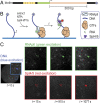Dynamics of RNA polymerase II and elongation factor Spt4/5 recruitment during activator-dependent transcription
- PMID: 33293419
- PMCID: PMC7768755
- DOI: 10.1073/pnas.2011224117
Dynamics of RNA polymerase II and elongation factor Spt4/5 recruitment during activator-dependent transcription
Abstract
In eukaryotes, RNA polymerase II (RNApII) transcribes messenger RNA from template DNA. Decades of experiments have identified the proteins needed for transcription activation, initiation complex assembly, and productive elongation. However, the dynamics of recruitment of these proteins to transcription complexes, and of the transitions between these steps, are poorly understood. We used multiwavelength single-molecule fluorescence microscopy to directly image and quantitate these dynamics in a budding yeast nuclear extract that reconstitutes activator-dependent transcription in vitro. A strong activator (Gal4-VP16) greatly stimulated reversible binding of individual RNApII molecules to template DNA. Binding of labeled elongation factor Spt4/5 to DNA typically followed RNApII binding, was NTP dependent, and was correlated with association of mRNA binding protein Hek2, demonstrating specificity of Spt4/5 binding to elongation complexes. Quantitative kinetic modeling shows that only a fraction of RNApII binding events are productive and implies a rate-limiting step, probably associated with recruitment of general transcription factors, needed to assemble a transcription-competent preinitiation complex at the promoter. Spt4/5 association with transcription complexes was slowly reversible, with DNA-bound RNApII molecules sometimes binding and releasing Spt4/5 multiple times. The average Spt4/5 residence time was of similar magnitude to the time required to transcribe an average length yeast gene. These dynamics suggest that a single Spt4/5 molecule remains associated during a typical transcription event, yet can dissociate from RNApII to allow disassembly of abnormally long-lived (i.e., stalled) elongation complexes.
Keywords: CoSMoS; Gal4-VP16; Saccharomyces cerevisiae.
Conflict of interest statement
The authors declare no competing interest.
Figures




Similar articles
-
Biochemical Analysis of Yeast Suppressor of Ty 4/5 (Spt4/5) Reveals the Importance of Nucleic Acid Interactions in the Prevention of RNA Polymerase II Arrest.J Biol Chem. 2016 May 6;291(19):9853-70. doi: 10.1074/jbc.M116.716001. Epub 2016 Mar 4. J Biol Chem. 2016. PMID: 26945063 Free PMC article.
-
The yeast transcription elongation factor Spt4/5 is a sequence-specific RNA binding protein.Protein Sci. 2016 Sep;25(9):1710-21. doi: 10.1002/pro.2976. Epub 2016 Jul 15. Protein Sci. 2016. PMID: 27376968 Free PMC article.
-
Spt4 facilitates the movement of RNA polymerase II through the +2 nucleosomal barrier.Cell Rep. 2021 Sep 28;36(13):109755. doi: 10.1016/j.celrep.2021.109755. Cell Rep. 2021. PMID: 34592154 Free PMC article.
-
Mechanisms of Transcription Elongation Factor DSIF (Spt4-Spt5).J Mol Biol. 2021 Jul 9;433(14):166657. doi: 10.1016/j.jmb.2020.09.016. Epub 2020 Sep 25. J Mol Biol. 2021. PMID: 32987031 Review.
-
The Spt4-Spt5 complex: a multi-faceted regulator of transcription elongation.Biochim Biophys Acta. 2013 Jan;1829(1):105-15. doi: 10.1016/j.bbagrm.2012.08.007. Epub 2012 Sep 6. Biochim Biophys Acta. 2013. PMID: 22982195 Free PMC article. Review.
Cited by
-
Eukaryotic gene regulation at equilibrium, or non?Curr Opin Syst Biol. 2022 Sep;31:100435. doi: 10.1016/j.coisb.2022.100435. Epub 2022 Oct 20. Curr Opin Syst Biol. 2022. PMID: 36590072 Free PMC article.
-
The molecular principles of gene regulation by Polycomb repressive complexes.Nat Rev Mol Cell Biol. 2021 Dec;22(12):815-833. doi: 10.1038/s41580-021-00398-y. Epub 2021 Aug 16. Nat Rev Mol Cell Biol. 2021. PMID: 34400841 Free PMC article. Review.
-
Transcriptional activators in the early Drosophila embryo perform different kinetic roles.Cell Syst. 2023 Apr 19;14(4):258-272.e4. doi: 10.1016/j.cels.2023.03.006. Cell Syst. 2023. PMID: 37080162 Free PMC article.
-
A transcriptional cycling model recapitulates chromatin-dependent features of noisy inducible transcription.PLoS Comput Biol. 2022 Sep 9;18(9):e1010152. doi: 10.1371/journal.pcbi.1010152. eCollection 2022 Sep. PLoS Comput Biol. 2022. PMID: 36084132 Free PMC article.
-
NusG-Spt5 Transcription Factors: Universal, Dynamic Modulators of Gene Expression.J Mol Biol. 2025 Jan 1;437(1):168814. doi: 10.1016/j.jmb.2024.168814. Epub 2024 Oct 5. J Mol Biol. 2025. PMID: 39374889 Free PMC article. Review.
References
-
- Thomas M. C., Chiang C. M., The general transcription machinery and general cofactors. Crit. Rev. Biochem. Mol. Biol. 41, 105–178 (2006). - PubMed
-
- Mayer A., et al. , Uniform transitions of the general RNA polymerase II transcription complex. Nat. Struct. Mol. Biol. 17, 1272–1278 (2010). - PubMed
-
- Vos S. M., et al. , Structure of activated transcription complex Pol II-DSIF-PAF-SPT6. Nature 560, 607–612 (2018). - PubMed
Publication types
MeSH terms
Substances
Grants and funding
LinkOut - more resources
Full Text Sources
Molecular Biology Databases

